| Four rules to put into practice |
During the London 2012 Olympic Games, the equestrian sport was held at the historic Greenwich Park, which was built around 1433 as a Royal Park. Though the site has neither stables nor courses for equestrian disciplines, temporary structures for the events were built. Great care and safety were incorporated into the design, especially for the horses and athletes. The anticipation of the magnitude of horse traffic and the obvious necessity of grooming was no small matter. There were 144 horses for the 2012 Olympics and 78 horses with the Paralympics Games at the park.
Safety for the groomer and athletic horses was a top priority at the Games and likewise should always be for any person involved with horses. Grooming is essential in the health of your horse and should be performed daily. There are four basic rules that you should always practice while grooming horses.
1. BE CALM, CONFIDENT, AND ESPECIALLY WISE AROUND HORSES. No sudden noises, movement or nervousness. These behaviors and actions will influence your horse into a nervous behavior as well. Know the temperament of the horse you’re working with and act accordingly to put him at ease.
2. WEAR BOOTS OR STEEL-ENFORCED SHOES WHILE GROOMING. The most common injury while grooming, or working with horses in general, is a foot being stepped on by the horse.
3. SPEAK TO THE HORSE WHILE GROOMING. Let them know that what you’re doing is reassuring. Avoid quick and jerky responses, as this could startle the horse.
4. STORE EQUIPMENT AWAY FROM THE HORSE AND WORK AREA. Grooming equipment or tools left around the horse can be chewed on, played with, or trampled on, potentially causing an injury to the horse or to you.
Horse sense is vital while working around horses. These tips are safety essentials for the grooming process. Never rush through grooming. Begin by standing close to the horse and with rhythmic motions start the currying, or grooming, by the left side of the horse’s neck. Work your way slowly and methodically toward the rump of the horse. To switch sides, place one hand on the horse’s rear quarter then walk around to the other side. Walking far enough around is another way, but never attempt to step over the lead rope or crawl under the lead or the horse’s belly.
CREDIT
article by J.P. SMITH

